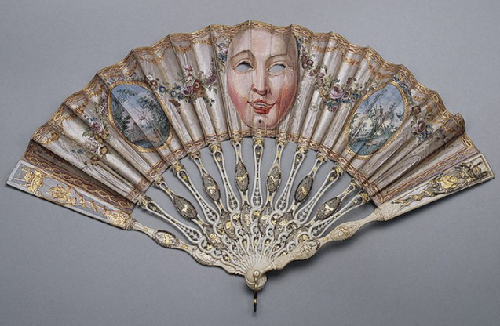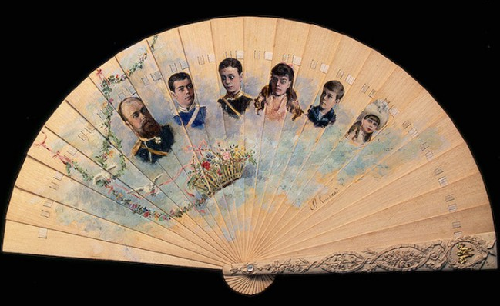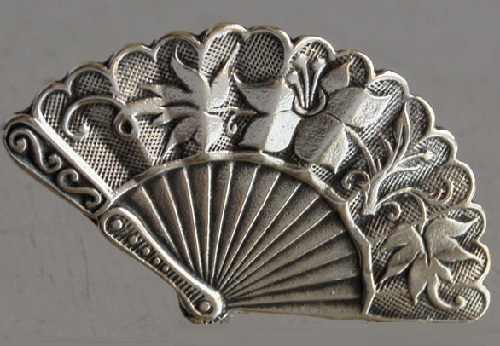Fan Kaleidoscope
Fan Kaleidoscope
With the departure of “Belle Epoque” the most necessary accessory of a civilized woman – fan became thing of the past. From now on, the invention of antiquity, not only female but also male accessory, has become only attribute of bohemian, artistic image. Almost all ancient peoples have stories and legends associated with a Fan. One says that when Adam and Eve ate the forbidden fruit, Eve tore a branch from a nearby tree, began to fan it, overcoming the embarrassment of her own nakedness. Chinese sources tell us about the famous beauty Lamsa, who during protracted ceremony, tired of stuffy and severity of precious robes, began to fan her mask, which caused indescribable delight of others, following her example.

Mask. France. 1770. Ivory, mother of pearl, copper and parchment; carved, inlaid and gilt silver foil, painted in gouache
The fan appeared in hot countries, where, thanks to this invention, people fleeing from insufferable heat and insects. The first fan was made of palm leaves or other plants, later they began to strengthen it with a long wooden handle, braided with leather. And then imagination knew no bounds: the screen in the form of a leaf woven from reeds, tight with parchment and fabric, carved of wood and ivory, made up of feathers of birds.
In ancient Egypt, the fan was a symbol of heavenly peace and happiness, and the position of fan holder on the left side of the nobleman was considered honorable. In ancient Greece, especially valued fan of peacock feathers. Inheriting to the Greeks, the Romans brought huge parties of peacock feather from the southern colonies, but, unlike the democratic Greece, where each was fanning himself, their fan was mounted on a long handle and “providing coolness” was concern of slaves. Ovid and other Roman writers wrote about their elegant, graceful tabellae cephalic fans of very thin plates of exotic trees impregnated with incense and essential during a banquet feasts.
Fan Kaleidoscope
Christians began to use a fan during the liturgy: two deacons with ritual vanes distilled insects from the Blessed Sacrament, and fanned bishop performing the ritual. The written sources of the Middle Ages did not spoil our frequent references to and images of fans. In the Renaissance, fan became a favorite accessory of ladies and gentlemen. On engravings of Cesare Vechellno and other Italian masters found a fan in the form of a weather vane or flag, while chatting was used a small fan-shaped vane of feathers. As a rule, a few ostrich feathers added together, the ends curled, handle made of gold and decorated with precious stones, and sometimes at the base of the vane inserted a small mirror.

Danish and Moscow coat of arms, 1867. Leather, silver; embossing, engraving, colored enamel inlay. (belonged to Empress Maria Feodorovna, wife of Alexander III)
Homeland of folding fan is considered to be Japan, where it served as the complement to traditional costume. The range of its application was extremely wide – from the court to the rituals of the tea ceremony and dance. But in the theater, size, color and pattern of fan characterized character, fan symbolic movement in the hand of actor replaced the scenery depicting the sun, moon, and natural disasters. Preserved evidence that the handles of ancient Japanese fans were made of cypress, and screens were decorated with painting and poetry – from paper or silk.
Japanese fighting fan in the shaped of vane of iron, steel, copper was a mandatory piece of suit of higher military ranks. Dexterous movement allowed to repel blows of the enemy with such fan, moreover, it was used as a commander’s baton. It was worn suspended from the wrist or belt at a special silk cord with a brush. Chinese borrowed folding fan and started doing it only of the plates connected to each other by one or more rows of silk ribbons. Later in Europe, it was named “Brise” (French).
The folding fan was brought to Europe from China by Portuguese traders in the late XV – beginning of XVI century. From Portugal, it was brought to England, Spain and Italy, and then from Italy – to France. Fan was especially liked thing at the court of Catherine de Medici. In addition to the usual fans, were fashionable fans in the form of cap badges with screens made of taffeta, the finest leather and parchment, painted with geometric or stylized floral patterns. Lever hidden in the handle, allowed to open a fan to 45, 90 and 360 degrees.
In the second half of XVII-XVIII centuries was flourishing fan art, fan was made in almost all European countries. English differed in exquisite taste, a fine study of details, although sometimes delusions to portray local flora and sign their Latin names turned fan almost into a manual of botany.

Shell-shaped fan. Company Duvelleroy, France. 1900s. Horn, gas, Pearl; gouache, mosaic embroidery and silk ribbon, engraving. (owned by one of the daughters of Nicholas II)
In Italy, counting on travelers on fans imprinted historical attractions: the ancient ruins, the Cathedral of St. Peter, the eruption of Mount Vesuvius. Authentic samples of the beauty and elegance were, of course, the works of French masters. Mother of pearl, tortoiseshell, ivory serve as material for handles which, in turn, were engraved, decorated through carving, painting, plates of gold. Screen plate and frame was decorated with multi-colored foil, sequins, gems. Sometimes the rim of plates were ingenious devices and small caches.
The inventory of the property of Russian queens repeatedly mention the eastern and western fan work. In a small number fans were produced in Moscow in the workshops of the Armory. The mother of Peter I Queen Natalia had a fan of black ostrich feathers with jasper handle inlaid with gold and decorated with precious stones.
With fan confessed in love, expressed contempt, appointed hour of visits, but only in the hands of dedicated fan became a real weapon of chivalry. Madame de Stael wrote that by the manner of handling of fan, there was no difficulty to distinguish the princess from the countess and the marquis from the burghers. In addition to the unification of all the gestures and manipulation, for friends, ladies and gentlemen, was patented different alphabet. The Museum of Fine Arts, Boston (USA) keeps released from the workshop of Robert Clark fan of the end of the XVIII with engraved on it “Guidelines for the language of the fan.” On it is placed the alphabet, divided into five groups of five letters, each letter also had its number. Each number corresponds to a certain movement:
1 – a fan in the right hand, 2 – in the left hand, 3 – it points to his chest,
4 – a fan at the lips, 5 – a fan at a head.
That is, any letter stands for the two movements. So it was possible “to say names, words, ask simple questions and answer them.
Storage case for fans was performed from different types of wood, tight with velvet, silk, morocco, and laid in wool and silk, preserving a fragile thing. On the top or on the inside of the lid was typed in gold the name of the manufacturer or the store. Imported fan from China and Japan was packaged in elegant lacquer boxes, often painted in the same manner as a fan itself.
Art Nouveau brought new themes and principles: from Japanese art came the way of portraying only one bird or flower on the fan. An exquisite addition to the evening and ballroom ladies toilets were considered Belle Epoque fans, lace screens with the holes for painted medallions. Handle was made of mother of pearl, decorated with engraving, carving and gilding-through, so these fans cost insanely expensive.
Extremely fashionable subjects at the end of the XIX century were scenes from the tragicomic life of Pierrot, a colorful circus – favorite theme painted on fan screens. In the early of the XX century in vogue once again returned the small screen of the fan with gas, crepe and tulle, richly embroidered with sequins of various shapes and sizes.
At the turn of XIX-XX centuries fans began to be used to advertise: on them were printed restaurant menus, programs, performances and opera librettos. Souvenir items dedicated to anniversaries of historical events, and the ruling monarchs in neighboring countries. Famous perfumers sent out fans to customers, with the name of perfume. On the eve of the First World War, fan was the most massive accessory in everyday life. But after the horrors of war, the most essential accessory of a civilized woman – fan sank into oblivion era. From now on, the fan will be attribute of bohemian, sometimes with a hint of kitsch, artistic, sometimes shocking image …
























